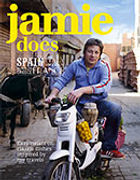- Healthy recipes
- Healthy snacks
- Healthy lunches
- Healthy chicken recipes
- Healthy fish recipes
- Healthy vegetarian recipes
- Main Ingredient
- Chicken
- Pasta
- Vegetables
- Fish
- Beef
- Eggs
- View more…
- Special Diets
- Vegan
- Vegetarian ideas
- Gluten-free
- Dairy-free
- Budget recipes
- One-pan recipes
- Meals for one
- Breakfast
- Desserts
- Quick fixes
- View more…
- Baking recipes
- Cakes
- Biscuit recipes
- Gluten-free bakes
- View more…
- Family recipes
- Money saving recipes
- Cooking with kids
- School night suppers
- Batch cooking
- View more…
- Special occasions
- Dinner party recipes
- Sunday roast recipes
- Dinner recipes for two
- View more…
- 5 Ingredients Mediterranean
- ONE
- Jamie’s Keep Cooking Family Favourites
- 7 Ways
- Veg
- View more…
- Nutrition
- What foods are good for gut health?
- Healthy eating tips
- Special diets guidance
- All about sugar
- Learn about portion size
- View more
- Features
- Cheap eats
- Healthy meals
- Air-fryer recipes
- Family cooking
- Quick fixes
- View more
- How to’s
- How to cook with frozen veg
- How to make the most of your oven
- How to make meals veggie or vegan
- View more
- More Jamie Oliver
- YesChef x Jamie Oliver
- Cookbook Club
- Jamie Oliver Group website
- Jamie Oliver Cookery School
- Ministry of Food
- Vegepedia
Beef tagine
Slow-cooked with squash, sticky prunes & chickpeas
- Dairy-freedf
- Gluten-freegf

Slow-cooked with squash, sticky prunes & chickpeas
- Dairy-freedf
- Gluten-freegf
“Spicy, fragrant and sweet, the perfect beef tagine doesn't need special equipment, just time. ”
Serves 4
Cooks In3 hours 40 minutes plus marinating time
DifficultySuper easy
Jamie Does...BeefDinner PartyMoroccanStewFamily one-pan recipes
Nutrition per serving
-
Calories 548 27%
-
Fat 19.6g 28%
-
Saturates 5.2g 26%
-
Sugars 23.6g 26%
-
Salt 1.1g 18%
-
Protein 46.4g 93%
-
Carbs 48.7g 19%
-
Fibre 11g -
Of an adult's reference intake
Tap For Method
Ingredients
- US
- Metric
- Portuguese
Would you rather see the UK version? Would you rather see the US version? Would you rather see the Australian version? Would you rather see the German version? Would you rather see the Dutch version? Você prefere ver a versão em português? Close
- 600 g stewing beef
- 1 onion
- ½ a bunch of fresh coriander
- olive oil
- 1 x 400 g tin of chickpeas
- 1 x 400 g tin of plum tomatoes
- 800 ml organic vegetable stock
- 800 g butternut squash
- 100 g prunes
- 2 tablespoons flaked almonds
- SPICE RUB
- 1 level tablespoon ras el hanout spice mix
- 1 level tablespoon ground cumin
- 1 level tablespoon ground cinnamon
- 1 level tablespoon ground ginger
- 1 level tablespoon sweet paprika
Tap For Method
The cost per serving below is generated by Whisk.com and is based on costs in individual supermarkets. For more information about how we calculate costs per serving read our FAQS
Tap For Ingredients
Method
- Mix all the spice rub ingredients together in a small bowl with a good pinch of sea salt and black pepper.
- Put the beef into a large bowl, massage it with the spice rub, then cover with clingfilm and place in the fridge for a couple of hours, preferably overnight.
- When you’re ready to cook, peel and finely chop the onion, and pick the coriander leaves, finely chopping the stalks.
- Heat a generous lug of oil in a tagine or casserole pan over a medium heat, add the meat and fry for 5 minutes to seal. Add the onion and coriander stalks and fry for a further 5 minutes.
- Drain and tip in the chickpeas, followed by the tomatoes, breaking them up with a spoon, then pour in 400ml of stock and stir well. Bring to the boil, then cover and reduce to a low heat for 1½ hours.
- Meanwhile, deseed and chop the squash into 5cm chunks, then destone and roughly tear the prunes. Toast the almonds in a dry frying pan until lightly golden, then tip into a bowl.
- When the time's up, add the squash, prunes and remaining stock. Give everything a gentle stir, then pop the lid back on and continue cooking for another 1½ hours. Keep an eye on it, adding splashes of water, if needed.
- At this stage, remove the lid and check the consistency. If it seems a bit too runny, simmer for 5 to 10 minutes, more with the lid off – the beef should be really tender and flaking apart now, so have a taste and season to taste.
- Scatter the coriander leaves over the tagine along with the toasted almonds. Serve with a big bowl of lightly seasoned couscous and dive in.
Tips
Ras el hanout (Arabic for "top of the shop") is a blend of the best spices a vendor has in his shop. The mixture varies depending on who is selling it, but can be a combination of anywhere from 10 to 100 spices. It usually includes nutmeg, cinnamon, mace, aniseed, turmeric, cayenne, peppercorns, dried galangal, ginger, cloves, cardamom, chilli, allspice and orris root.
Related recipes
Simon Pegg's lamb tagine
Wonderful veg tagine
Related features
52 Festive alternatives to Turkey
How to make beef tacos
How to make the best beef stew recipe
Related video
Moroccan beef tagine: Jamie Oliver
© 2024 Jamie Oliver Enterprises Limited
- Terms of Use
- Privacy Policy
- Cookies
- Jamie Oliver Group
- Contact
- Sitemap
© 2024 Jamie Oliver Enterprises Limited
